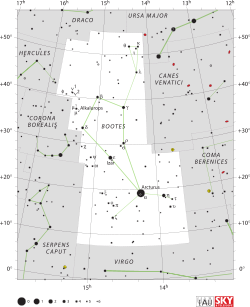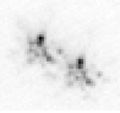Zeta Boötis
| Observation data Epoch J2000 Equinox J2000 | |
|---|---|
| Constellation | Boötes |
| Right ascension | 14h 41m 08.95158s[1] |
| Declination | +13° 43′ 41.8967″[1] |
| Apparent magnitude (V) | 3.78[2](4.46 + 4.55)[3] |
| Characteristics | |
| Spectral type | A2III + A2III[4] A1V[5] |
| U−B color index | +0.05[2] |
| B−V color index | +0.05[2] |
| Astrometry | |
| Radial velocity (Rv) | −8.5±0.6[6] km/s |
| Proper motion (μ) | RA: +51.95 mas/yr[1] Dec.: -11.08 mas/yr[1] |
| Parallax (π) | 18.56 ± 0.76 mas[1] |
| Distance | 176 ± 7 ly (54 ± 2 pc) |
| Absolute magnitude (MV) | +0.13[7] |
| Details | |
| A | |
| Mass | 2.2[8] M☉ |
| B | |
| Mass | 2.2[8] M☉ |
| HIP 71759 | |
| Mass | 1.655±0.131[9] M☉ |
| Radius | 1.738±0.114[9] R☉ |
| Luminosity | 8.85±0.28[9] L☉ |
| Temperature | 7,570±253[9] K |
| Orbit[10] | |
| Primary | A |
| Companion | B |
| Period (P) | 45,460±62 d |
| Semi-major axis (a) | 2.3±1.7″ |
| Eccentricity (e) | 0.9977±0.0034 |
| Inclination (i) | 102.3±9.2° |
| Longitude of the node (Ω) | 8.2±2.6° |
| Periastron epoch (T) | 2,460,183.5±57 JD |
| Argument of periastron (ω) (secondary) | 262.9±5.9° |
| Other designations | |
| A: HD 129247, HR 5478[12] | |
| B: HD 129246, HR 5477[13] | |
| Database references | |
| SIMBAD | data |
Zeta Boötis, Latinized from ζ Boötis, is a triple star system in the constellation of Boötes. They have the Flamsteed designation 30 Boötis; Zeta Boötis is the Bayer designation. This system is visible to the naked eye with a combined apparent magnitude of +3.78.[2] The individual magnitudes differ slightly, with component A having a magnitude of 4.46 and component B at the slightly dimmer magnitude 4.55.[3] It is located at a distance of approximately 180 light years from the Sun based on parallax,[1] but is drifting closer with a radial velocity of −9 km/s.[6]
The duplicity of this star was discovered by English astronomer William Herschel in 1796, and their changing positions have been tracked from 1823 onward.[14] They complete an orbit roughly every 124.5 years (45,460 days). The orbit of this pair has a very high eccentricity of 0.9977, bringing the stars within 0.3 AU at their closest approach. The next close approach will occur during August 2023.[10] Together with the distant companion HIP 71759, Zeta Boötis make a triple star system. This distant star has an estimated orbital period of three million years, being at an observed distance of 41,300 au (6,180×109 km; 0.653 ly) from the inner pair.[8]
In 1976, T. W. Edwards found a stellar classification of A2III for both components, suggesting they may be evolved A-type giant stars. Helmut A. Abt reported a class of A2V in 1981, which matches an A-type main-sequence star.[15] Abt and Nidia Morrell updated the classification to A1V in 1995.[5] Considering the extreme nature of their orbit, it is unlikely that any companion exoplanets could have stable orbits around either star.[16]
Gallery
[edit]- Zeta Bootis imaged with the Nordic Optical Telescope on 13 May 2000 using the lucky imaging method. (The Airy discs around the stars is diffraction from the 2.56m telescope aperture.)
- Typical short-exposure image of a binary star, as seen using speckle imaging through the Earth's atmosphere.
References
[edit]- ^ a b c d e van Leeuwen, F. (November 2007), "Validation of the new Hipparcos reduction", Astronomy and Astrophysics, 474 (2): 653–664, arXiv:0708.1752, Bibcode:2007A&A...474..653V, doi:10.1051/0004-6361:20078357, S2CID 18759600
- ^ a b c d Nicolet, B. (1978), "Photoelectric photometric Catalogue of homogeneous measurements in the UBV System", Astronomy and Astrophysics Supplement Series, 34: 1–49, Bibcode:1978A&AS...34....1N.
- ^ a b Mason, B. D.; et al. (2014), "The Washington Visual Double Star Catalog", The Astronomical Journal, 122 (6): 3466–3471, Bibcode:2001AJ....122.3466M, doi:10.1086/323920.
- ^ Edwards, T. W. (April 1976), "MK classification for visual binary components", Astronomical Journal, 81: 245–249, Bibcode:1976AJ.....81..245E, doi:10.1086/111879.
- ^ a b Abt, Helmut A.; Morrell, Nidia I. (July 1995), "The Relation between Rotational Velocities and Spectral Peculiarities among A-Type Stars", Astrophysical Journal Supplement, 99: 135, Bibcode:1995ApJS...99..135A, doi:10.1086/192182.
- ^ a b Gontcharov, G. A. (2006), "Pulkovo Compilation of Radial Velocities for 35 495 Hipparcos stars in a common system", Astronomy Letters, 32 (11): 759–771, arXiv:1606.08053, Bibcode:2006AstL...32..759G, doi:10.1134/S1063773706110065, S2CID 119231169.
- ^ Anderson, E.; Francis, Ch. (2012), "XHIP: An extended hipparcos compilation", Astronomy Letters, 38 (5): 331, arXiv:1108.4971, Bibcode:2012AstL...38..331A, doi:10.1134/S1063773712050015, S2CID 119257644.
- ^ a b c Waisberg, Idel; Klein, Ygal; Katz, Boaz (March 2024). "Hidden Companions to Intermediate-mass Stars. XVI. Unveiling a 41,300 au Companion to the Very Eccentric Binary Zeta Boötis". Research Notes of the AAS. 8 (3): 55. Bibcode:2024RNAAS...8...55W. doi:10.3847/2515-5172/ad2df5. ISSN 2515-5172.
- ^ a b c d Hardegree-Ullman, Kevin K.; Apai, Dániel; Bergsten, Galen J.; Pascucci, Ilaria; López-Morales, Mercedes (2023-06-01). "Bioverse: A Comprehensive Assessment of the Capabilities of Extremely Large Telescopes to Probe Earth-like O2 Levels in Nearby Transiting Habitable-zone Exoplanets". The Astronomical Journal. 165 (6): 267. arXiv:2304.12490. Bibcode:2023AJ....165..267H. doi:10.3847/1538-3881/acd1ec. ISSN 0004-6256.
- ^ a b Muterspaugh, Matthew W.; et al. (December 2010), "The Phases Differential Astrometry Data Archive. II. Updated Binary Star Orbits and a Long Period Eclipsing Binary", The Astronomical Journal, 140 (6): 1623–1630, arXiv:1010.4043, Bibcode:2010AJ....140.1623M, doi:10.1088/0004-6256/140/6/1623, S2CID 6030289.
- ^ "zet Boo". SIMBAD. Centre de données astronomiques de Strasbourg. Retrieved 2020-12-31.
- ^ "zet Boo A". SIMBAD. Centre de données astronomiques de Strasbourg. Retrieved 2020-12-31.
- ^ "zet Boo B". SIMBAD. Centre de données astronomiques de Strasbourg. Retrieved 2020-12-31.
- ^ Wierzbiński, St. (1956), "Orbites des étoiles doubles", Acta Astronomica, 6: 82, Bibcode:1956AcA.....6...82W.
- ^ Abt, H. A. (1981), "Visual multiples. VII. MK classifications", The Astrophysical Journal Supplement Series, 45: 437, Bibcode:1981ApJS...45..437A, doi:10.1086/190719.
- ^ Muterspaugh, Matthew W.; et al. (December 2010), "The Phases Differential Astrometry Data Archive. III. Limits to Tertiary Companions", The Astronomical Journal, 140 (6): 1631–1645, arXiv:1010.4044, Bibcode:2010AJ....140.1631M, doi:10.1088/0004-6256/140/6/1631, S2CID 9272936.
External links
[edit]- Kaler, James B., "ZETA BOO (Zeta Bootis)", Stars, University of Illinois, retrieved 2011-12-18
- HR 5477
- Image Zeta Boötis
- CCDM J14411+1344


 French
French Deutsch
Deutsch

